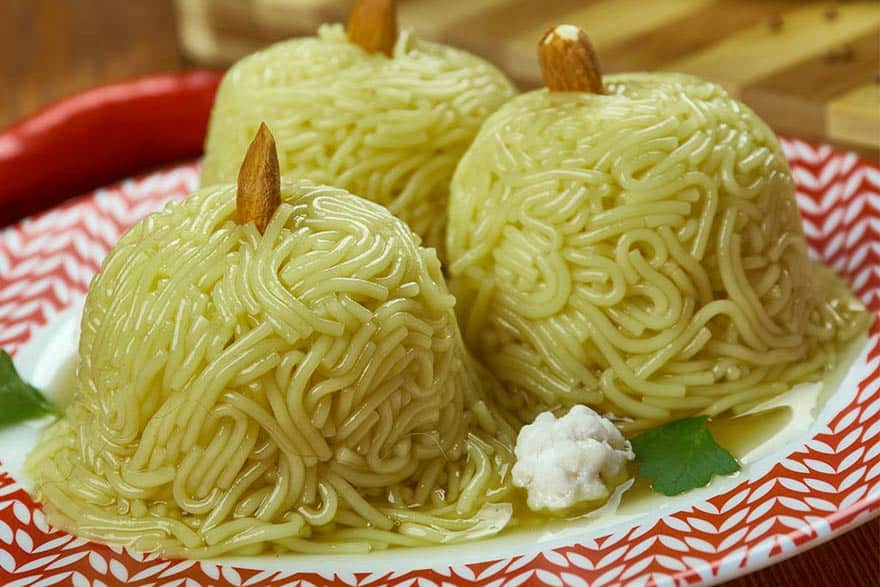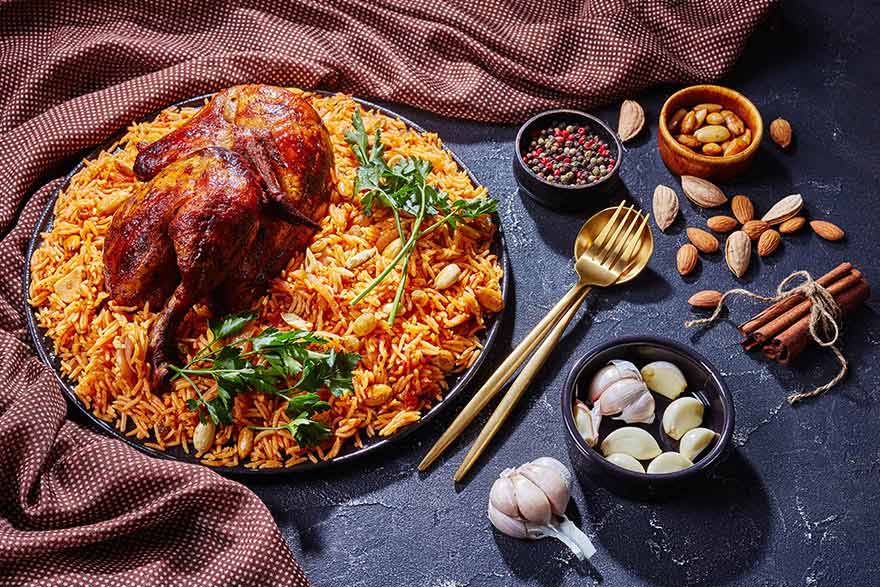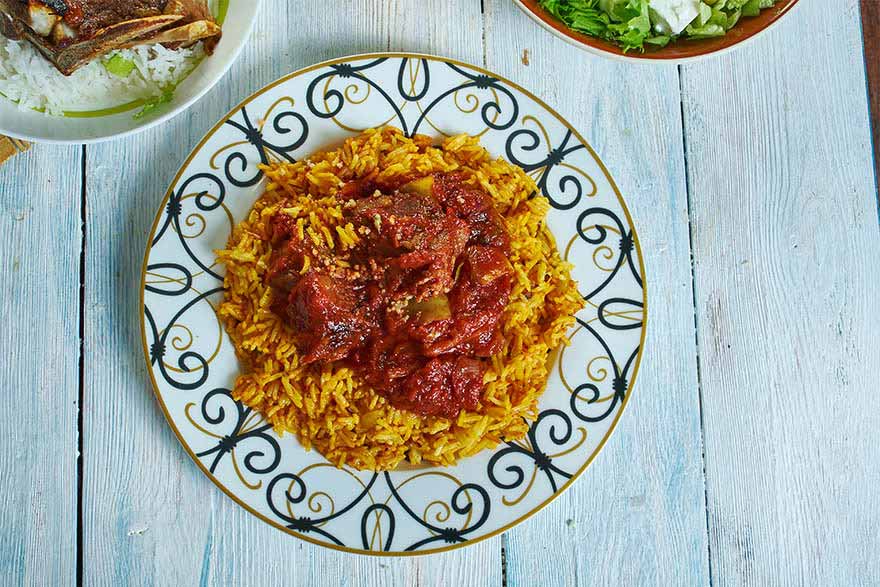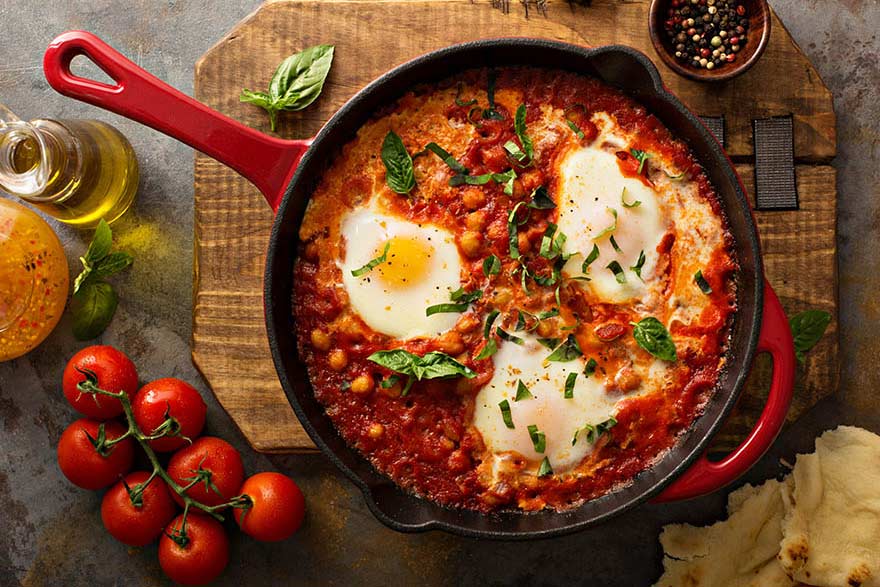The Middle East is home to incredible landscapes, modern architectural wonders and ancient cultural sites, but the warm hospitality from locals — and the food — may leave the biggest impression on you. From hearty entrees seasoned with a range of spices to irresistible desserts, these are some of our favorite foods in Jordan, Egypt, Saudi Arabia, Israel and beyond:
Jordan

Mansaf is Jordan’s national dish, and it is often prepared on a large platter for communal eating. The base is a thin layer of flatbread, which is covered with steaming rice and tender pieces of lamb meat. The meat is often soaked in jameed, a flavorful yogurt sauce, and topped with toasted nuts. Another popular meal is maqluba, which contains a mix of rice, eggplant, cauliflower, potatoes, and either lamb or chicken. The rice is cooked in meat broth and arranged in a pot with meat and vegetables, and then flipped over to serve. Hummus and falafel are also staples in Jordan — and just about every country in the Middle East.
Knafeh (or kunafa) is one of the most common desserts in Jordan, and this crispy, cheesy treat is unlike anything you’ve ever tried. A pan of soft cheese (either goat, ricotta, or mozzarella) is topped with a layer of vermicelli noodles that have been soaked in syrup. The entire dish is baked, and then topped with more syrup and pistachios. Another popular dessert is basbousa, a dense, sticky cake made from semolina flour. Orange blossom or rose water syrup is poured over the cake as soon as it is removed from the oven, and individual slices are topped with almonds.
Egypt

Ful medames is a simple soup recipe that dates to ancient Egypt, and it is a common breakfast dish. Made from mashed fava beans, olive oil, lemon juice, garlic, cumin and other spices, it is often served with fried eggplant and falafel. You can’t leave Egypt before trying koshari, a tasty entree with a variety of textures and flavors. The base is usually a mix of rice and pasta, topped with chickpeas, lentils, garlic, tomato sauce, and a generous handful of crispy fried onions. When it comes to meat dishes, shawarma and kabobs are quite popular, and for a lighter bite, you can’t beat hawawshi. A mixture of minced meat, vegetables and spices is stuffed in a piece of traditional baladi bread and baked, making for a crispy and filling snack.
Egyptian desserts draw inspiration from all over the Middle East, ranging from baklava to Balah el Sham, which are fried pastries covered in syrup. One of the most famous desserts is Umm Ali, a bread pudding that is a signature dish at Egyptian weddings.
Oman

Kabuli is one of Oman’s most popular dishes, consisting of lamb or beef stew mixed with rice and a variety of spices, including cardamom, clove, masala and black pepper. The dish is served with bread, and there are a few different kinds. Omani Maldouf is made from a thicker dough that is often used for flatbread, while khubz rahal (or Omani khubz) is a paper-thin bread served on a snack plate with cheese and honey. Kebabs are popular in Oman, but you’ll find them listed on the menu as “mishkak.”
Oman is famous for its date palm plantations, which produce a variety of the tasty, tender fruits. Dates, known locally as seh, are often presented to house guests, and they are used in a number of desserts. Halwa means dessert in Arabic, but it’s also the name of a popular Omani custard made of eggs, ghee (clarified butter), farina, caramelized sugar, honey and rose water. Flavored with cardamom and topped with nuts, this sticky treat is commonly served with coffee. Halawet Ahmad is another delectable dessert made with vermicelli, sweetened condensed milk, coconut, butter and almond powder, and topped with pistachios. Omanis are also big on coffee, or kahwa, which is usually mixed with cardamon powder.
Saudi Arabia

While the recipe for kabsa originated in Yemen, it is the national dish of Saudi Arabia. Kabsa is a delicious rice dish made with meat and vegetables, plus dried fruits and nuts. Meat lovers will also enjoy dajaj mashwi, a Saudi barbecue dish made with boneless chicken breasts marinated in lime juice, garlic, ginger, oil and a combination of spices and herbs.
Hanini is a traditional Saudi dessert made with date paste, brown flour and ghee, plus spices like cardamom and saffron. Often prepared during the winter months, many restaurants have put their own spin on the crumbly treat, adding toppings like cream, caramel or nuts. If you’re lucky enough to visit during the Holy Month of Ramadan, you’ll want to try to find a bakery selling qatayef, which are pancakes stuffed with soft cheese and nuts, and soaked in rose water syrup.
Qatar

The key to many Qatari foods is slow cooking — and adding a variety of spices and herbs. Majboos is the national dish of Qatar, and it is full of incredible flavors. Seasoned rice is topped with tender lamb or chicken meat, and the plate is generally served with salad. Another local favorite is saloona, a traditional stew usually made with a tomato-based broth, sautéed onions, garlic, ginger, vegetables and either beef, chicken, lamb or fish. While stuffed vine leaves (waraq enab) are a common snack in the Middle East, Qatar puts a special twist on theirs, using ground beef or lamb and rice, seasoned with garlic, pepper and coriander. Stuffed zucchini, or kousa mahshi, is another popular light bite, and the veggies are typically filled with minced meat, rice and spices and served fresh from the oven.
Karak is the Qatari drink of choice, and this sweet tea, which contains milk, cardamom and sugar, is boiled three times to achieve its flavor and consistency. Craving something sweet to pair with a cup of karak? Stop by a local market and pick up luqaimat, which are deep-fried dough balls soaked in syrup and flavored with saffron and cardamom.
Israel

Though shakshouka originated in Northern Africa in the 16th century, it became a classic meal when Jewish immigrants brought the dish to Israel in the 1950s. This popular breakfast dish consists of poached eggs served in a pan of hot tomato sauce seasoned with chili, garlic and onion. Falafel is Israel’s national dish, and you’ll find the chickpea fritters on street markets and in restaurants. You can enjoy falafel as a tasty snack with a side of hummus or stuffed into a pita with salad (usually finely diced cucumbers, onion, tomatoes and peppers), hummus, pickles and tahini sauce. Sabich is another popular pita meal, stuffed with fried eggplant slices, salad, hard-boiled eggs and tahini sauce.
Malabi is one of Israel’s most popular desserts, and the creamy milk pudding is often topped with rose water jelly and crushed pistachios. Sesame candy, chocolate balls and halvah are also high on the list of sweet treats, and if you’re exploring a street market, be sure to grab a sfenj, which is essentially a doughnut, but served hot and coated with honey or powdered sugar.
United Arab Emirates

Restaurants in the United Arab Emirates serve a range of internationally inspired cuisine, but there are plenty of traditional meals on the menu, too. Ghuzi (or khuzi) is a simple rice dish made with roasted lamb, topped with vegetables and nuts. Al harees, which has the consistency of porridge, is another option if you’re looking for a solid meal. After boiling a pot of wheat in salt water for several hours, chunks of meat (usually lamb, chicken or veal) are added, and the dish is cooked for several more hours.
You’ll find luqaimat in most cafes and bakeries in the UAE, but there are plenty of local Emirati treats to try during your visit, too. Aseeda is a warm pumpkin pudding mixed with cardamom and saffron, topped with rose water, honey and nuts. If you’re looking for a bite-sized treat to accompany a cup of coffee, batheeth is sure to hit the spot. The small cookies are made of date paste, wheat flour, spices like cardamom and ginger and rolled into balls, and you’ll often find them topped with sesame seeds and nuts.





